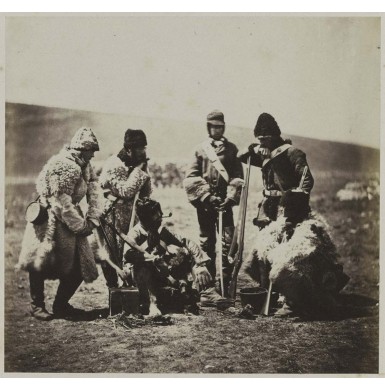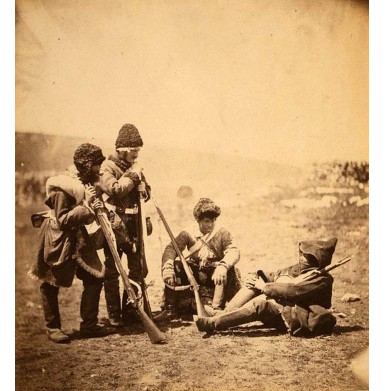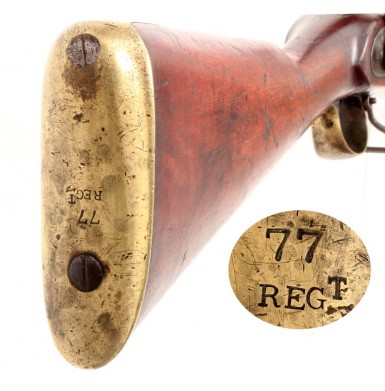The Pattern 1851 Mini” Rifle is one of the least often encountered of all general issue British military percussion long arms. The gun was the first rifled percussion arm to be widely issued to the British line infantry, replacing the smoothbore M-1842 percussion musket, and foreshadowing the end of the Napoleonic Era “rifle regiment”. The gun was adopted in 1851 and was manufactured from 1852 through 1855, with some 35,000 total rifle muskets being produced. It appears that nearly every one of the P-1851s saw service, as English arms researcher and author DeWitt Bailey notes that by April of 1855 approximately 34,000 P-1851s had been issued for service. At the beginning of the Crimean War, the P-1851 was the most advanced weapon in the British military small arms arsenal, even though it was essentially obsolete and was already about to be replaced by the new, smaller bore P-1853 “Enfield”. The P-1851 was in reality a compromise arm that allowed the British military to adopt a modern rifled musket for general issue, while at the same time appeasing the very conservative Duke of Wellington who felt that the smoothbore musket in the hands of line infantry was queen of the battlefield. Wellington’s views on the use of musketry by the infantry had not much changed since his victory over Napoleon at Waterloo in 1815, and he still felt that any inadequacies that might exist in the smoothbore infantry musket could be overcome by training of the infantry. As such, as pressure arose to adopt some form of rifled long arm for the service, Wellington specified that the new gun be able to accept the current service ammunition in an emergency, and specified the weight of the new bullet, as well as setting requirements for its downrange effectiveness in terms of power, what we would call kinetic energy today. He additionally insisted that 50 rounds of the new ammunition not weigh more in the cartridge box than 60 rounds of the older round ball ammunition did. These requirements prevented the Board of Ordnance from adopting a significantly smaller bore weapon as they had hoped to, and resulted in a rifled musket design that was nominally .708” caliber. Trials by the small arms committee of the Board of Ordnance investigated a number of designs, ranging from the Prussian breechloading needle rifle to a pillar-breech rifle by Charles Lancaster, as well as a design based upon the Belgian made Mini” Rifle. In the end the Li’ge design was the winner. The newly adopted P-1851 Mini” Rifle retained much of the styling of the earlier P-1842 musket, with a barrel secured by keys (wedges), and brass pipes to retain the ramrod. Unlike the .75 caliber P-1842, the gun had a slightly smaller bore, measuring .708 and a 39” long barrel that was rifled with four broad, fairly deep grooves of uniform depth. An adjustable long-range rear sight was affixed to the upper rear of the barrel, which was graduated to a maximum distance of 900 yards. The balance of the gun was essentially the same as the earlier pattern smoothbore percussion muskets that it was designed to replace. The first 500 arms that were set and delivered were subsequently issued to 10 elite regiments in the regular army, with each receiving 50 of the guns for use and evaluation. Among these regiments were the 7th, 19th, 48th, 77th and 95th regiments of foot. Almost immediately the two primary defects in the design were identified; the rear sight was problematic and the ramrod needed improvement. The rear sight was found to have inconsistent and inaccurate graduations on its ladder, leading to accuracy issues with long distance shooting. Additionally the sight was not consistently installed in the same location on the musket, and the elevating slider did not remain in the positions it was placed in when the ladder was raised. The ramrod was found difficult to remove from the rammer channel when the hands of the soldier were wet or greasy, and improved head design was suggested. Due to the very limited service life of the P-1851, these issues were never fully addressed. The P-1851s performed fairly well in the Crimea, with their first major “trial by fire” occurring at the battle of Inkerman (November 5, 1854) where the Mini” Rifles gave a decided advantage to the British, allowing them to hold off and defeat a Russian force almost three times their size, but armed with obsolete smoothbore muskets, many of which were still flintlocks. Despite the initial success of the P-1851 it was quickly supplanted by the newly adopted P-1853 “Enfield” Rifle Musket. This gun was a major advance in infantry long arm design and featured a reduced caliber bore of .577, a more advanced rear sight and a barrel secured by clamping barrel bands, instead of the M-1851’s wedges. The P-1851 was so quickly replaced by the new technology of the “Enfield” that at the conclusion of the Crimean War the guns were considered completely obsolete. The hierarchy of the British military expected long arms to have a useable service life of 10 years, and required even obsolete weapons to be held in reserve for emergency issue for at least that long before being offered for sale. The surviving Pattern 1851 Mini” Rifles from the Crimean were held in such low regard after the adoption of the P-1853 that many of the guns were “stored” outside, exposed to the weather in an area adjacent to the Tower of London known simply as “the ditch”. More than likely this “storage area” was in fact the old moat that surrounded the Tower in earlier days, and it appears that due to a poorly managed and somewhat corrupt ordnance supply system, much of the surplus materiel from the war in the Crimea suffered a similar fate. With the coming of the American Civil War, and the urgent need for infantry long arms by both sides, a large number of obsolete British arms were sold as surplus, most of which were sold to the Confederacy by S. Isaac, Campbell & Company. According to Confederate purchasing records, some 14,900 British Pattern 1851 Mini” Rifles were purchased during the early days of the war. Most of these arms were purchased between August of 1861 and January of 1862, with a handful purchased in the summer of 1862. Records indicate that at least 10,000 of these arms (and probably all of them) were purchased from J.E. Barnett & Sons of London, who had acquired the guns from the British Ordnance Department. Due to the fact that the arms had been left exposed to the elements in the Tower ditch for several years, Barnett refurbished the guns to make them functional. This apparently included the replacement of worn, damaged or missing parts and also involved re-proving the guns at the London Proof House. All known examples of Confederate imported Pattern 1851 Mini” Rifles show at least the remnants of their original British military proofs, and often a secondary set of London commercial proofs, applied during the Barnett refurbishment process. Barnett sold the majority of the arms to S. Isaac & Campbell at a rate of 40 shillings each, including the socket bayonet, and the Confederacy was charged 44 shillings. The summer of 1862 purchases were sold to the Confederacy at the lower rate of 40 shillings each. The guns were inspected by Messrs Curtis and Hughes, who had been hired by S. Isaac & Campbell to act as viewers of arms. The P-1851s inspected by Curtis & Hughes bear the inspection mark of CH / 1 in a small circle, on the upper comb of the stock, forward of the buttplate tang. Confederate documents refer to the Pattern 1851 rifle muskets by a number of different names, including “Old Army Pattern, rifled”, “Second Hand Government Rifles”, “Mini” Rifles”, “Second Hand Rifles 1851 Pattern” , “Brown Bess Rifles 1851 Pattern” and “Rifled Brown Bessies”. Pattern 1851 Rifle Muskets were arriving in Confederate ports no later than January of 1862, with deliveries continuing throughout most of that year. Of these the Federal Blockading Squadron captured some 3,520 of the guns, but 11,380 appear to have been successfully delivered. The obsolete muskets that were captured were likely destroyed, and the arms that made it to Confederate hands saw very hard use, and today less than a dozen Confederate marked P-1851 Mini” Rifles are known to exist. With roughly half of the P-1851s produced seeing use in another major conflict, and many of the remaining guns left to languish in the Tower “ditch” it is easy to understand why so few of the 35,000 guns produced have survived to be found in collections today.
The P-1851 Mini” Rifle offered here is in about VERY GOOD+ to NEAR FINE condition. The gun is a pure British military example and shows no indication of having been refurbished and sold to the Confederacy. The stock shows indications of heavy use, with numerous bumps and dings from service, but the gun remains in crisp condition with no abuse noted. The musket is 100% complete and correct, which is certainly uncommon for a P-1851 and all of the usual parts that are typically missing (rear sight, ramrod, Lovell’s catch) are present. The gun is clearly and well marked throughout, with all marks in the metal remaining very legible. The most interesting mark is on the bottom of the butt plate, which is stamped, upside down, 77REGT. As noted above, the 77th was one of the first 10 regiments to receive the P-1851 for trial purposes. The marking on the butt certainly does not follow standard British military marking protocol, but may have been applied to the early production trials guns from the initial issue or may have been applied in the field in the Crimea. The 77th carried P-1851s in the Crimea, and used them at all the major battles they were engaged in, including Inkerman. A couple of Fenton images (the “Brady” of the Crimean War) are included below with the pictures of the musket, showing the 77th in the field in the Crimea carrying P-1851 Mini” Rifles in winter dress. These images are from the on line catalog of items in the National Army Museum (England).
The lock of the rifle musket is engraved in the typical manner for the P-1851 and has the usual (CROWN) / VR at the tail of the lock and the date 1852 / TOWER forward of the hammer. The usual British military (CROWN) / (BROAD ARROW) acceptance mark is present on the lock as well. The original British military proof marks are crisp and visible at the left breech of the musket. These include a (CROWN) / (BROAD ARROW) followed by a (CROWN) / B / 9 and a (CROWN) / TT / (BROAD ARROW). The top of the breech is also struck with a (CROWN) / (BROAD ARROW) acceptance mark. The bottom of the barrel is marked with the usual British military proof and inspection marks, including a (CROWN) / B / 7 and a (CROWN) / B / 3. The barrel is additionally marked H&S / Y for Hollis & Sheath, and with the initials R.W and J.M. Hollis & Sheath were among the four “old contractors’ who delivered the entire initial order of P-1851 Mini” Rifles. The other three contractors included Thomas Turner, Swinburn & Son and Tipping & Lawden. The bottom of the barrel also has two sets of assembly mating marks X \ / | | | and \ / | |. Both of those assembly marks are found on the lower edge of the lock as well. The interior of the lock is marked J.M over the mainspring, and G&F near the bridle. The interior is stamped with a (CROWN) / B / 6 inspection mark, and the inside of the hammer neck is stamped with a (CROWN) / B / 12 mark. Both of the lock mounting screws bear the mating mark X \ / | | |, as does the barrel tang screw. The marks are also found on the edges of the three barrel wedges. The same mating mark is found in the ramrod channel, along with some blurred Crown/B/# inspection marks and an illegible stock maker’s name. The metal of the gun is mostly smooth, with some lightly scattered pinpricking present as well as some small patches of minor surface oxidation. The barrel has a lovely, smooth plum brown patina over most of its exposed surfaces, with only some light pitting around the breech and bolster area and the muzzle. There may be some traces and fleck of the original barrel browning mixed with the attractive patina. The lock has a mottled gray appearance, with a smooth pewter base color and darker gray mottling and some lightly oxidized surface staining. Some minor traces of the original case hardened coloring of the lock may actually be present within the mottled patina. The bore of the gun is in about GOOD+ to VERY GOOD condition. The bore retains well-defined 4-groove rifling, and is lightly to moderately pitted along its entire length. A good scrubbing could well improve the overall condition of the bore. Unlike most Pattern 1851 Mini” Rifles, this gun is 100% complete, correct and original. It retains both of the original sling swivels, as well as the complete long-range rear sight (including the delicate ladder and adjustable slide). The gun also retains its original and correct ramrod, which retains barely visible 1 mark near the concave button head. The rod is full-length and retains good threads on the opposite end. The original Lovell’s Pattern bayonet catch is in place under the barrel. This is another delicate piece that is usually missing when a P-1851 is found available for sale. The lock of the gun is mechanically excellent and functions perfectly on all positions. The brass furniture has a lovely, dark and untouched ochre patina that is very attractive. The stock of the musket is in about VERY GOOD overall condition. The stock is solid and sound, with no breaks, cracks or repairs. The stock does show a significant number of bumps, dings and mars from carry and use during its military service life. The musket clearly saw use, but was never really abused. There is a small sliver of wood missing along the upper edge of the stock line, on the right side, just forward of the middle pipe. This area is worn smooth with age and the sliver was almost certainly lost during the period of use. The stock bears an interesting brand on its obverse that I have not identified. It is a large circle with the center divided into quarters, with the mark W T B & S Co. It is not clear who the “WTB & C Company” is, or why they branded the gun. I would have to assume that this mark was applied after the musket had completed its British military service life, and was applied by a surplus dealer or the company that purchased the gun for use. Any further information would be appreciated.
Overall this is a really wonderful, completely correct and original example of a British military Pattern 1851 Mini” Rifle. Considering the hard life that the gun likely experienced during the Crimean War, in post-war storage and in some form of post-British military service life, the gun is really in remarkably good condition. The 77th Regiment of Foot marking on the buttplate certainly implies that the musket was present at Inkerman, the Siege of Sevastopol and Alma, where it no doubt saw hard service. The scarcity of any type of P-1851 on the collector market cannot be understated, and many collectors have searched for one of these muskets for more than a decade and been unable to find one. Some have searched even longer, hoping to find a 100% complete example that remains in reasonably crisp condition. This is just such a gun, a truly rare British military musket that is an essential part of any serious mid-19th century British military collection and a gun that would be a fantastic addition to any advanced Crimean War collection.
SOLD











